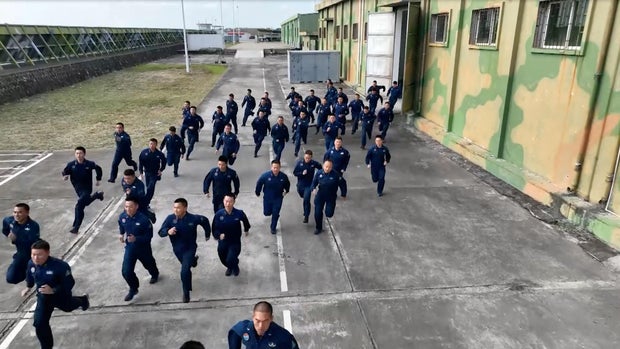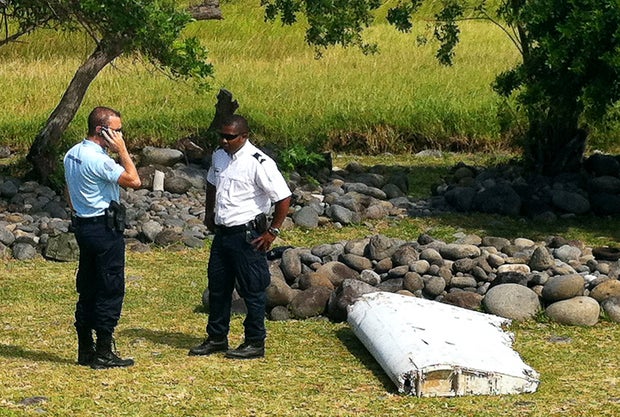CBS News
U.S. and Philippines launch war games as Taiwan detects record number of Chinese military aircraft around island

Thousands of U.S. and Filipino troops launched joint exercises in the northern and western Philippines on Tuesday, after China held huge drills around Taiwan and a Chinese vessel collided with a Filipino patrol boat.
The exercises came as Taiwan detected a record 153 Chinese military aircraft around the self-ruled island, official data showed Tuesday. The aircraft were spotted in the 25 hours to 6:00 am on Tuesday, the defense ministry said in a statement — the most for a single day.
The annual Kamandag, or Venom, exercises are focused on defending the north coast of the Philippines’ main island of Luzon, which lies about 500 miles from self-ruled Taiwan.
Beijing considers Taiwan part of its territory and has vowed it will never rule out using force to take it, calling Monday’s drills a “stern warning” to “separatist” forces on the island.
Taiwan condemned China’s actions as “irrational and provocative”, and the U.S. called them “unwarranted”.
“This military pressure operation is irresponsible, disproportionate, and destabilizing,” Pentagon Press Secretary Maj. Gen. Pat Ryder said in a statement.
Tingshu Wang / REUTERS
The joint U.S.-Filipino exercises also come days after a collision between a Chinese and a Philippine vessel in the South China Sea.
It was the latest in a series of confrontations between the two countries in the strategic waterway claimed almost entirely by Beijing.
Philippine Marine Corps commandant Major General Arturo Rojas stressed at Tuesday’s opening ceremony in Manila that Kamandag was long planned and had “nothing to do with whatever is happening in the region.”
The drills’ primary focus will be live-fire exercises along Luzon’s north coast, while other activities will be conducted on tiny Philippine islands between Luzon and Taiwan.
“It’s a coastal defense doctrine. The doctrine says that a would-be aggressor might be directed towards our territory,” Filipino exercise director Brigadier-General Vicente Blanco told reporters.
“We are not exercising to join the fight (over Taiwan),” he added.
U.S. Marines representative Colonel Stuart Glenn said the exercises were aimed at helping the United States and its allies respond to “any crisis or contingencies.”
The western Philippine island of Palawan, facing the South China Sea, will also host part of the drills.
The U.S. and Philippines are fielding just over 1,000 participants each, while smaller numbers of Australian, British, Japanese and South Korean forces are also taking part.
An amphibious landing and training on how to defend against chemical and biological warfare were also among the activities planned, according to a press kit.
Ship “deliberately sideswiped” by Chinese vessel
As the war games began Tuesday, the Philippine government announced that the BRP Datu Cabaylo, a civilian patrol vessel, had sustained minor damage on October 11 when it was “deliberately sideswiped” by a “Chinese Maritime Militia” vessel.
The collision dented the 100-foot vessel’s front right section, the Bureau of Fisheries and Aquatic Resources said in a statement. It took place about 5.8 miles from Thitu, a Philippine-garrisoned island in the Spratly group.
Prior to the collision, the Chinese vessel also “conducted dangerous manoeuvres and tried to block the path” of the Filipino boat, which was conducting routine patrol, the bureau said.
The crew were unhurt and later sailed the vessel to Thitu.
“What they did to us is against international law and violates our sovereign rights in the West Philippine Sea,” Nazario Briguera, the spokesman for the fisheries bureau, told AFP, using Manila’s term for its claimed sections of the South China Sea.
He said the Datu Cabaylo was the third vessel owned by the bureau that was damaged in clashes with Chinese vessels this year.
China has repeatedly rammed Philippine ships and blasted them with water cannons over the last two years. A “60 Minutes” crew got a close look at the tense situation when traveling on a Philippine Coast Guard ship that was rammed by the Chinese Coast Guard.
Beijing has for years sought to expand its presence in contested areas of the sea, brushing aside an international ruling that its claim to most of the waterway has no legal basis.
PLA EASTERN THEATRE COMMAND
China has in recent months deployed military, coast guard, as well as what the Philippines and its allies describe as “maritime militia” forces in a bid to eject the Philippines from a trio of other strategically important reefs and islands in the South China Sea.
CBS News
7-year-old girl killed, 6 other people wounded in stabbing attack at school in Croatia, police say

Stipe Majic/Anadolu via Getty Images
A 7-year-old girl was killed and at least five other students and a teacher were wounded in a knife attack at a school in the Croatian capital, Zagreb, on Friday, police said. The local hospital said the wounded teacher had suffered life-threatening injuries, Reuters reported.
Officials said the attack happened at 9:50 a.m. local time at the Precko Elementary School in the neighborhood of the same name. They described the attacker as a “young male” and said he had been detained.
Croatia’s Interior Ministry said the attacker was 19 years old. Local media reported the attacker was a former student at the school, and showed video footage of children running away from the school building and a medical helicopter landing in the schoolyard.
Croatian Prime Minister Andrej Plenkovic said he was “appalled” by the attack, and that authorities are still working to determine exactly what happened. He said several children have been taken to various hospitals in Zagreb.
State television reported the attacker went straight into the first classroom he found after entering the school, where he attacked the students and their teacher.
School attacks are rare in Croatia. Last May, a teenager in neighboring Serbia opened fire at a school in the capital Belgrade, killing nine fellow students and a school guard.
CBS News
Malaysia agrees to launch new search for MH370 plane, which vanished a decade ago with 239 people on board

Malaysia announced on Friday it has agreed to launch a new search for Malaysia Airlines flight MH370, which disappeared 10 years ago in one of aviation’s greatest enduring mysteries.
The Boeing 777 carrying 239 people disappeared from radar screens on March 8, 2014 while en route from Kuala Lumpur to Beijing.
Despite the largest search in aviation history, the plane has never been found. Malaysia’s prime minister said 17 days after the plane disappeared that, based on the satellite data, his government had concluded that the plane crashed down in a remote corner of the Indian Ocean, and that there were no survivors.
Transport Minister Anthony Loke said Malaysia had agreed to a new search operation by maritime exploration firm Ocean Infinity, which also carried out an unsuccessful hunt in 2018.
The company’s first efforts followed a massive Australia-led search for the aircraft that lasted three years before it was suspended in January 2017.
Loke said a new 5,800 square mile area of the southern Indian Ocean would be scoured by Ocean Infinity, which is based in the United Kingdom and United States.
“The new search area proposed by Ocean Infinity is based on the latest information and data analysis conducted by experts and researchers,” Loke said.
“The proposal for a search operation by Ocean Infinity is a solid one and deserves to be considered,” he told reporters.
The government said it agreed to Ocean Infinity’s proposal “in principle” on December 13, with the transport ministry expected to finalize terms by early 2025.
The new search will resume “as soon as the contract is finalized and signed by both parties”, Loke said.
“They have informed us that the ideal time for the search in the designated waters is between January and April. We are working to finalise the agreement as quickly as possible,” he added.
“I truly hope there will be an end to the loss of MH370. May all questions be answered,” Malaysian Rosila Abu Samah, 60, the stepmother of one of the passengers, told AFP.
Supian Ahmad/NurPhoto/Getty
Malaysian Shim Kok Chau, 49, whose wife was a flight attendant on the ill-fated flight, said he had come to accept her fate but hopes to know what happened to the plane, “why it happened and who did it.”
Among the other victims was a celebrated group of 24 Chinese calligraphy artists coming from an exhibition of their work. Two young Iranian men on the plane, 18-year-old Pouria Nour Mohammad Mehrdad and 29-year-old Delavar Seyed Mohammadreza, were traveling on stolen passports to seek better lives in Europe.
Two of the U.S. citizens on the plane were young children, Nicole Meng, 4, and 2-year-old Yan Zhang.
Philip Wood was the only American adult on the flight. The IBM executive had been living in Beijing and was planning to relocate to the Malaysian capital with his girlfriend, Sarah Bajc.
“No find, no fee”
The new search will be on the same “no find, no fee” principle as Ocean Infinity’s previous search, with the government only paying out if they find the aircraft.
The contract is for 18 months and Malaysia will pay $70 million to the company if the plane is found, Loke said.
He said the decision to agree to a fresh search “reflects the Malaysian government’s commitment to continuing the search operation and providing closure to the families of the MH370 victims.”
The original Australia-led search covered 120,000 square kilometers in the Indian Ocean but found hardly any trace of the plane, with only some pieces of debris picked up.
In July 2015, an airplane fragment later confirmed to be a flaperon from MH370 was found washed ashore on the western Indian Ocean island of Reunion. It was the first hard evidence that the plane had gone down in the area. More debris was later found washed up on the coast of eastern Africa.
YANNICK PITOU/AFP/Getty Images
The plane’s disappearance has long been the subject of theories — including that veteran pilot Zaharie Ahmad Shah had gone rogue.
A final report into the tragedy released in 2018 pointed to failings by air traffic control and said the course of the plane was changed manually.
Asked if he was confident the plane will be found during the new search, Loke said: “At this point, no one can provide guarantees.
“It has been over 10 years, and it would be unfair to expect a concrete commitment. However, under the terms and conditions, any discovery must be credible. It cannot just be a few fragments; there are specific criteria outlined in the contract.”
CBS News
News details emerge about Utah mother, 3 young children killed at their home

A Utah mother who police believe was shot and killed by her husband along with three of their children was a refugee who fled violence in Myanmar and dreamed of thriving with her family in the U.S., relatives said Thursday.
Police believe the husband killed his family before shooting himself, and a teenage son was badly wounded.
The bodies of Bu Meh, 38, along with her daughters Kristina Ree, 8, and Nyay Meh, 2, and son Boe Reh, 11, were found in their home in West Valley City, a Salt Lake City suburb, on Tuesday. A handgun was found under the father Dae Reh, 42, leading police to believe this was a murder-suicide, but no evidence of a motive has been released.
One child, 17-year-old Sha Reh, survived being shot in the head and is hospitalized with a severe brain injury, police said.
Bu Meh, a member of Myanmar’s Karenni ethnic minority, fled what her relatives described as ethnic cleansing in the Southeast Asian nation about 10 years ago. She and her small family lived for a time in a refugee camp in Thailand, then came to the United States “with little more than the clothing on their backs,” the family said in a statement.
She taught herself English, learned new skills and worked hard to support her growing family, achieving a way of life “far beyond the nightmare of her former country or the refugee camp,” the family said.
“For reasons that we cannot comprehend, her husband robbed her and their children of that security and their very lives,” her family said.
Police believe the shooting happened over the weekend.
Police initially went to the home Monday night after a relative asked them to check on the family but did not find any sign of an emergency that would allow them to enter the home. The relative went to the home Tuesday, saw Sha Reh wounded in the garage and called police, who found the bodies inside the home.
In their statement, relatives called Sha Reh their hero and said he faces a “long and complex road to recovery.” An online fundraiser is collecting donations to pay for his care and to help him go to college.
“After moving into their own home and finally enjoying a level of prosperity far beyond the nightmare of their former country or the refugee camp in Thailand in which they lived for a season, and for reasons that we cannot comprehend,” the family wrote, “her husband robbed her and their children of that security and their very lives.”
Neighbors hadn’t reported any gunshots in the area over the weekend, police spokesperson Roxeanne Vainuku said at a news conference Wednesday. The family had no previous reports of domestic violence or other disturbances.
One neighbor spoke to CBS affiliate KUTV about the shock they felt.
“How can a father shoot his children?” neighbor Mike Webster told the station. “I just can’t grasp for that concept at all. I can just see that poor little two-year-old looking at her daddy.”
This Utah case is the 38th mass killing in the United States this year. At least 165 people have died this year in U.S. mass killings, which are defined by the FBI as cases in which four or more people die within a 24-hour period, not including the killer.
Mark Barden, whose child was killed in the 2012 Sandy Hook school shooting, urged Utah lawmakers to pass Red Flag laws after the incident in Utah, KUTV reported.
“When it is recognized that an individual is in crisis, measures to safely and temporarily remove firearms from their possession are proven to save lives,” Barden said.














